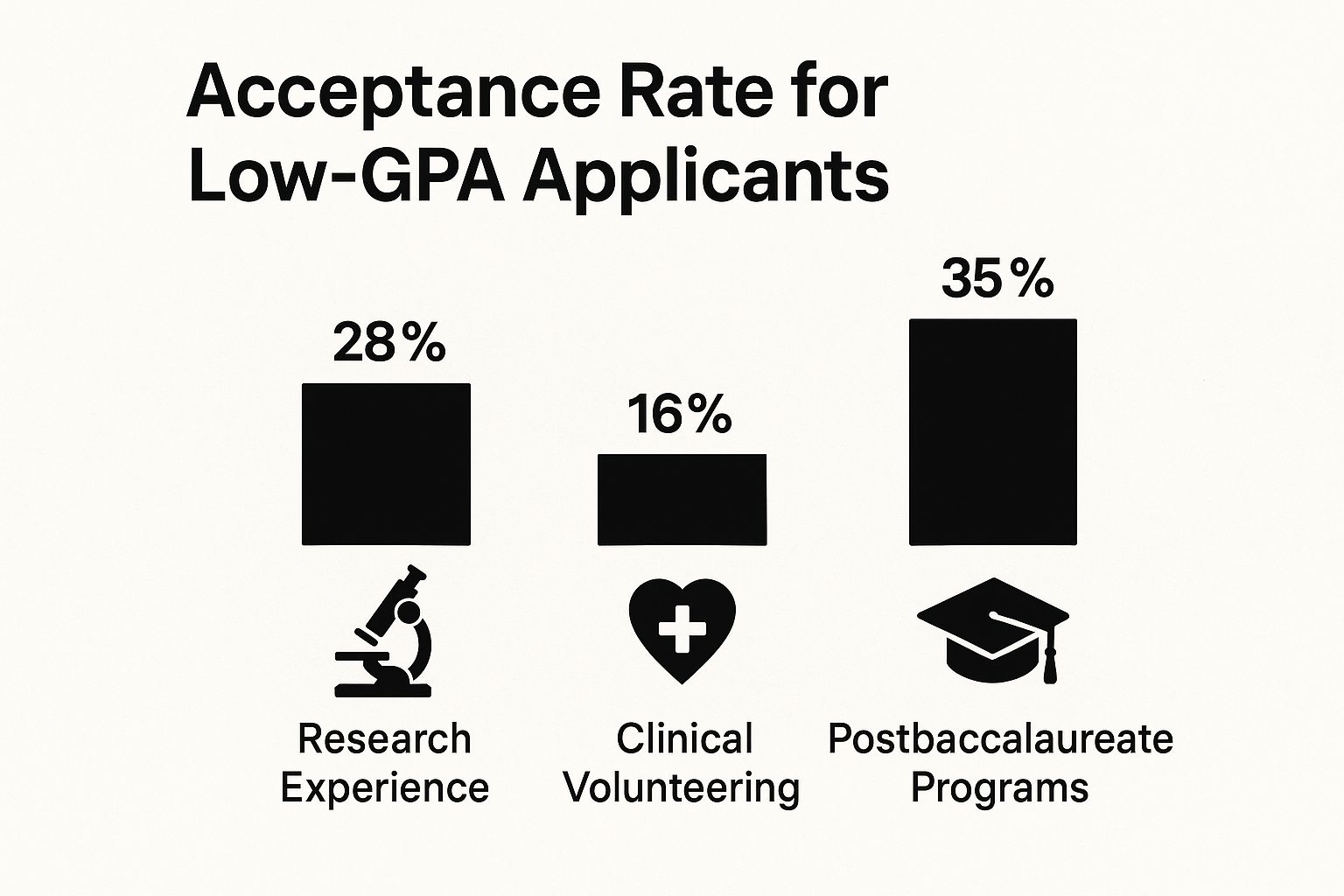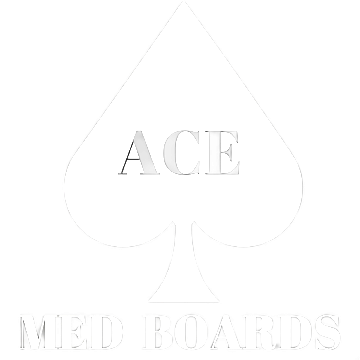It's the question that keeps countless pre-meds up at night: is my dream of becoming a doctor over because of a few bad semesters?
The short answer is a definitive no. While a low GPA is a hurdle, it's far from an insurmountable barrier. Getting into medical school with a lower GPA is absolutely possible, but it demands a smart, strategic approach to the rest of your application.
Your GPA is just one piece of the puzzle. A high MCAT score, a compelling personal story, and meaningful extracurriculars can create a powerful case for your admission. The key is to shift the admissions committee's focus from a single number to the complete picture of who you are.
Does a Low GPA Ruin Your Medical School Chances?

Let's be direct: a low GPA makes things harder, but it doesn't ruin your chances. Why? Because medical school admissions committees are increasingly using a holistic review process. This means they look beyond raw statistics to understand you as a person and a future physician.
This approach acknowledges that a transcript doesn't always tell the whole story. Maybe you were working two jobs to pay for school, faced a family emergency, or simply took some time to find your academic footing. A low GPA medical school acceptance often hinges on your ability to provide this crucial context.
The Power of a Holistic Application
Think of your application as a collection of evidence you're presenting to make a case for yourself. Your GPA is one piece, but it can be balanced by other, more compelling evidence.
A stellar MCAT score, for instance, is a direct counterpoint to a shaky GPA. It demonstrates your capacity to handle the scientific rigor of medical school right now. The overall acceptance rate for U.S. medical schools hovers around 41%, but this figure is heavily influenced by your stats. Many schools have a soft cutoff around a 3.0 GPA, making it critical to build strength elsewhere.
This is where your MCAT prep comes in. Investing 300 to 500 hours in focused MCAT preparation isn't just about hitting a number; it's about proving your critical thinking skills and scientific competency. You can learn more about how schools weigh these numbers by exploring medical school GPA and MCAT requirements.
Your experiences also carry immense weight—they are your opportunity to show qualities that numbers never can.
- Clinical Experience: This isn't about checking a box. Sustained, meaningful roles in a clinical setting show your genuine dedication to patient care.
- Research Involvement: Contributing to a research project proves your intellectual curiosity and analytical skills. It shows you're comfortable with the scientific process.
- Personal Narrative: Your essays are where you connect all the dots. This is your chance to frame your academic journey as a story of resilience, growth, and learning.
The goal isn't to make excuses for your GPA. It's to build such a compelling case with the rest of your application that admissions committees see your academic record as a small part of a much larger, more impressive picture.
Ultimately, your application must tell the story of someone who is prepared, passionate, and resilient. By strategically highlighting your strengths and providing context for your challenges, you can successfully navigate the admissions process and earn that acceptance letter.
To help you visualize this strategy, here's a breakdown of how to strengthen each part of your application to offset a lower GPA.
How to Offset a Low GPA in Your Medical School Application
This table outlines key application components and provides actionable strategies to make them stand out, effectively compensating for a lower GPA.
| Application Component | Strategy to Compensate for Low GPA |
|---|---|
| MCAT Score | Aim for a score significantly above the average for your target schools. This directly proves your academic capability for med school-level science. |
| Personal Statement | Craft a compelling narrative that shows growth, resilience, and maturity. Address your academic challenges head-on (without making excuses). |
| Extracurriculars | Focus on long-term, meaningful commitments over a long list of shallow experiences. Quality and impact are more important than quantity. |
| Letters of Recommendation | Cultivate strong relationships with professors and mentors who can write detailed, personal letters that speak to your character and abilities. |
| Upward Trend | If your GPA improved over time, highlight this trend. It demonstrates your ability to adapt and succeed academically. |
| Post-Bacc or SMP | Consider a post-baccalaureate program or a Special Master's Program (SMP) to prove you can excel in graduate-level science courses. |
By focusing on these areas, you demonstrate that your GPA is a reflection of your past, not a predictor of your future success in medicine. You're showing the admissions committee that you have the dedication and skills required to become an excellent physician.
Turning Your Academic Past into a Powerful Narrative
Your personal statement is the single best chance you have to give context to your numbers. For anyone hoping for a low gpa medical school acceptance, this essay isn't just a box to check—it's the absolute heart of your application.
The trick is to frame your academic journey not as a list of excuses, but as a genuine story of growth, resilience, and self-discovery. Admissions committees have seen it all. They know a perfect transcript doesn't automatically mean someone will be a great doctor. Your job is to show them the person behind the GPA, someone who learned from setbacks and came out stronger and more focused.
This is where you turn a potential red flag into a testament to your character.
Own Your Story Without Making Excuses
The biggest mistake I see applicants make is sounding defensive. Instead of saying, "My grades suffered because I had a hard time adjusting to college," you need to reframe it to highlight what you learned from that experience. Show, don't just tell.
For instance, a student who stumbled their first year could talk about how that reality check forced them to develop rock-solid time management skills or a completely new, more effective way to study. That kind of narrative shows maturity and a proactive approach to solving problems—exactly the traits you need as a physician.
The goal is to connect your past struggles to your future strengths. Frame your challenges as the very experiences that forged the resilience, empathy, and dedication required to excel in medicine.
This approach shows the committee that whatever issues led to a lower GPA are firmly in the past. It proves you're now more than ready for the academic rigor of medical school. To really nail this, it helps to see how others craft persuasive narratives; you can find inspiration by looking at effective CV letters that tell a compelling story.
Showcase a Clear Upward Trend
An upward academic trend is maybe the most powerful piece of evidence you can offer. It’s tangible proof of your growth and commitment. When you talk about it, get specific.
- Pinpoint the Turning Point: What happened that lit a fire under you? Was it a specific class, a volunteer experience, or a personal realization that cemented your commitment to medicine and your studies?
- Highlight Subsequent Success: Don't be shy about mentioning your improved grades in those tough, upper-level science courses. Acing biochemistry or physiology sends a clear message: you can handle the material.
- Connect It to Your "Why": Tie your academic turnaround directly to your motivation for medicine. Maybe volunteering at a free clinic was the wake-up call you needed to get serious, and your grades shot up as a result.
This arc—from struggle to focus to success—is incredibly powerful. It shows that you don't just quit when things get tough. You adapt, you learn, and you overcome. Staying organized is critical to telling this story effectively across your entire application, so using a detailed medical school application checklist will help keep all the moving parts aligned.
Ultimately, you want to leave the admissions committee with one clear impression: your academic past, with all its bumps in the road, has uniquely prepared you to be a compassionate and resilient physician.
Building an Extracurricular Profile That Stands Out

When your GPA is a weak spot, your extracurriculars have to do the heavy lifting. They become the most compelling proof you have to show you're more than just a number. This is your shot to demonstrate the qualities a transcript can't capture—like empathy, resilience, teamwork, and a genuine, lasting commitment to service.
For any applicant trying to secure a low gpa medical school acceptance, a thoughtfully built extracurricular profile isn't just a good idea; it's non-negotiable.
Admissions committees (AdComs) are looking for depth, not just a long list of activities. A resume packed with shallow, short-term commitments looks like you’re just trying to check boxes. It’s far better to focus on a few key experiences where you’ve shown real growth and stuck with it for the long haul.
Go Beyond Shadowing in Clinical Settings
Let’s be clear: passive shadowing is a starting point, but it's not enough to move the needle. To really make an impression, you need active, hands-on clinical experience where you’re actually interacting with patients and contributing to the healthcare environment. This is how you prove you understand what medicine is really like—the good, the bad, and the messy.
Think about roles that come with real responsibility. This could mean:
- Volunteering consistently at a free clinic
- Working as an EMT or a Certified Nursing Assistant (CNA)
- Becoming a medical scribe
These roles throw you right into the world of patient care. They show a level of grit and dedication that simply watching a doctor for a few hours a week can never convey.
The most powerful clinical stories come from evolving from an observer into a participant. Showing how you took on more responsibility over time—maybe by training new volunteers or helping manage patient intake—tells a story of reliability and growth that AdComs love to see.
Your aim should be to rack up hundreds, if not thousands, of hours. But this isn't just about hitting some magic number. It's about the depth of experience you gain over that time. A long-term commitment shows that your interest in medicine isn't just a whim; it's a core part of who you are.
Demonstrate Your Scientific Curiosity Through Research
Research experience is another critical piece of the puzzle, especially if your science GPA is what’s holding you back. Getting involved in a lab shows your intellectual curiosity and your ability to handle the scientific process that forms the very foundation of medicine. It proves you can think critically, work with data, and be a productive member of a demanding, team-focused project.
You don't need a first-author publication in Nature. What you do need is meaningful involvement. Think of it in tiers:
- Good: Working as a lab assistant, cleaning glassware, learning basic techniques, and being reliable.
- Better: Taking ownership of a small piece of a larger project. You understand the hypothesis, you contribute to collecting data, and you can explain your role.
- Best: Presenting your work, even just at a campus symposium. Contributing to a poster presentation or earning a co-authorship on a paper is a huge plus.
A glowing letter of recommendation from your Principal Investigator (PI) can be absolute gold. It provides third-party validation of your work ethic and scientific mind, directly pushing back against any doubts raised by a lower GPA.
Showcase Your Humanity Through Service
Finally, don’t ever underestimate the power of non-medical community service. At its heart, medicine is a profession of service. AdComs want to see that you have a genuine desire to help people, period.
Long-term volunteering at a soup kitchen, mentoring kids from underserved communities, or working with a local non-profit shows your character. These experiences reveal who you are as a person and prove that your desire to help isn't just confined to a hospital. It's a fundamental part of your identity.
Sometimes, this human element is the very thing that tips the scales in your favor when a committee is on the fence about your application.
Applying Smarter, Not Just Harder
Firing off applications to dozens of medical schools without a clear strategy is one of the fastest ways to burn through your time, money, and emotional reserves. When you're dealing with a lower GPA, a scattergun approach is a recipe for disappointment. You have to be strategic.
The whole game changes when you build a targeted school list that actually fits your profile. It’s about putting your application in front of admissions committees who are most likely to look past the numbers and appreciate the unique journey you’ve taken.
Instead of just chasing the big-name research institutions, you need to broaden your horizons. Look for programs whose missions genuinely align with your strengths. Many schools are actively looking for applicants with a proven commitment to primary care or serving rural and underserved communities. These programs often value real-world experience and dedication far more than a flawless academic transcript.
Identifying Your Best-Fit Schools
A smart application strategy means digging deeper than the national rankings. You need to get into the weeds and understand the specific values and missions of different programs.
- Doctor of Osteopathic Medicine (DO) Programs: DO schools are famous for their holistic approach—not just in patient care, but in admissions, too. They place significant weight on an applicant's experiences and character, making them a fantastic option for anyone trying to secure a low gpa medical school acceptance.
- In-State Public Schools: Your local, state-funded medical schools often have a mandate to train doctors who will stick around and serve the local population. Because of this, they tend to favor in-state applicants and are more likely to consider a wider range of experiences.
- Newer Medical Schools: Newer institutions are still building their reputation and are often focused on creating a diverse, dynamic student body from the ground up. They can be more open to non-traditional applicants and people who bring unique life perspectives to the classroom.
Your goal is to find schools that will see your entire story, not just a single number on a transcript. The difference in acceptance rates can be staggering. While a hyper-selective school like Stanford might have an acceptance rate as low as 2%, some state schools can have in-state acceptance rates of 18% or even higher.
These numbers prove that a low GPA isn't a dead end—if you apply to the right places. Spend some time exploring data to see how acceptance rates vary by medical school and build a list grounded in reality.
This infographic really drives home how different experiences can shift the odds for applicants with lower GPAs.

As you can see, things like a post-bacc program or substantial clinical experience aren't just checking a box; they can fundamentally change how an admissions committee views your academic record.
Medical School Types and Their Approach to Low GPAs
Choosing the right type of medical school is crucial. This table breaks down where applicants with lower GPAs might find a more receptive audience.
| School Type | Typical GPA/MCAT Focus | Holistic Review Emphasis | Best For Applicants Who… |
|---|---|---|---|
| Top-Tier Research (MD) | Very High (3.8+ GPA, 518+ MCAT) | Moderate; strong research is key. | Have a high MCAT to offset GPA and significant research experience. |
| In-State Public (MD) | Moderate to High (varies by state) | High; strong ties to the state are a big plus. | Are in-state residents with strong community service or clinical experience. |
| Private MD Schools | High | Varies; some focus on specific missions. | Have a unique story or background that aligns with the school's mission. |
| DO Schools | Moderate | Very High; life experience is highly valued. | Have significant clinical/volunteer hours and a commitment to primary care. |
| Newer MD/DO Schools | Moderate | High; looking to build a diverse class. | Are non-traditional, have a unique background, or a strong upward trend. |
This isn't about "easier" schools, but about finding a better philosophical fit between your application and the institution's goals.
Creating a Balanced Application List
Your final school list should be a healthy mix of "reach," "target," and "safer" schools, categorized based on their median accepted GPA and MCAT scores. While your GPA is in the rearview mirror, your MCAT score is a powerful lever you can still pull.
A high MCAT score is one of the single most effective ways to counterbalance a lower GPA. It proves you have the academic horsepower to handle the rigors of medical school, despite any past struggles. If you need to boost your score, check out our guide on how to improve your MCAT score for practical strategies.
By focusing your efforts on schools that value your specific background—whether that's a passion for rural health, a career-changer's perspective, or a deep commitment to osteopathic principles—you move from being a low-stat applicant to being the ideal candidate for their program.
This targeted approach transforms your application process from a game of chance into a calculated strategy built for success.
Using Post-Bacc and Master's Programs to Your Advantage

Sometimes, the best way to deal with a low undergraduate GPA is to hit the reset button and build a brand new academic record. This is exactly what Post-Baccalaureate (post-bacc) and Special Master's Programs (SMPs) are designed for. They offer a powerful, focused path to reinvention for med school hopefuls.
Think of these programs not as an extension of your undergrad years, but as a high-stakes opportunity to prove you can handle the intense demands of medical school. Excelling in these tough, graduate-level science courses sends a clear message to admissions committees: your past performance doesn't define your current capabilities.
This strategy works because it directly tackles the number one concern raised by a low GPA—your ability to succeed in a notoriously difficult curriculum.
Choosing the Right Path for Academic Enhancement
First things first, it's crucial to understand that not all post-bacc programs are the same. Some are built for career-changers who need to knock out their pre-med requirements from scratch. If you're looking for a low gpa medical school acceptance, you need something different: a program specifically designed for academic enhancement.
These programs generally fall into three buckets:
- Special Master's Programs (SMPs): These are the heavy hitters. They're typically one-to-two-year programs, often run directly by a medical school. In many SMPs, you’ll be taking classes right alongside first-year medical students, giving you a chance to prove yourself on the exact same playing field.
- Formal Post-Bacc Programs: These are structured university programs that grant a certificate upon completion. They're laser-focused on advanced science coursework designed to boost your science GPA and show an upward trend.
- DIY Post-Bacc: This is the most flexible route, where you enroll in upper-level science courses at a local university as a non-degree-seeking student. While it offers control over your schedule and finances, it often lacks the structured support, advising, and "brand recognition" of a formal program.
Success in a reputable SMP is arguably the strongest form of academic redemption you can get. Earning a high GPA in a program where you're graded against actual medical students demonstrates in real-time that you are absolutely ready for the challenge ahead.
Making Your Investment Count
Let's be clear: these programs are a huge investment of both time and money. They are high-risk, high-reward. Just getting through the program isn't enough; you have to crush it. A mediocre performance, unfortunately, can do more harm than good by reinforcing the very doubts your undergrad transcript raised in the first place.
Admissions committees need to see that you’ve not only overcome past academic hurdles but have also developed the discipline and study skills to thrive. A stellar performance in a post-bacc or SMP, paired with a solid MCAT score, can effectively neutralize a lower undergrad GPA, prying open doors that might have seemed permanently closed.
For instance, a school with a holistic review process like Southern Illinois University School of Medicine sees average incoming GPAs in the 3.5 to 3.9 range. Excelling in a post-bacc program makes you a much more compelling applicant at schools that truly value a candidate's entire journey. You can learn more about how different schools approach admissions stats on MedSchoolCoach.com. This new academic chapter is your proof that you are ready, resilient, and all-in on your future in medicine.
Common Questions About Low GPA Medical School Acceptance
When you're navigating the application process with a GPA that's less than stellar, a ton of questions pop up. Getting clear, practical answers is the first step toward building a strategy that actually works and helps you sidestep the common traps.
One of the first things students ask is whether they should retake a class to get rid of a bad grade. Here's the deal: most medical schools will just average the old and new grades together, not replace the original one. A much stronger move is to prove your current academic chops by crushing new, advanced science courses. This shows you have what it takes now, which is far more impressive than trying to rewrite the past.
Distinguishing Between MD and DO Applications
Another big question is how to think about applying to MD versus DO programs, especially when your stats are a concern. DO schools have a well-earned reputation for their holistic review process. They often put more weight on an applicant's life experiences, character, and a genuine commitment to primary care.
While DO programs are still incredibly competitive, they can be more open to a compelling story of growth that puts a lower GPA into context. This makes them a smart, strategic addition to any school list, particularly for non-traditional applicants. For a deeper dive, our complete guide on how to get into medical school breaks down more strategies for building your application.
The best approach isn’t about hiding a low GPA. It's about building an application so strong and well-rounded that your GPA becomes just one small part of a much bigger, more impressive story of resilience and dedication.
Addressing an Academic Gap
What if you have a significant gap in your academic history? That's another common worry, but it doesn't have to be a deal-breaker. The key is to frame this time productively in your personal statement and secondary essays. Talk about what you learned from work, personal growth, or other experiences you had during that gap.
Admissions committees really value maturity and real-world perspective. Showing how that time away solidified your decision to pursue medicine can turn what looks like a red flag into a major strength. It also helps to stay plugged into the medical world by keeping up with broad advancements and research, like the kind of insights from the International Conference on Health, Medicine, and Life Sciences. This demonstrates a proactive engagement that goes way beyond coursework, signaling that you're a serious and committed future physician.
At Ace Med Boards, we specialize in helping students turn academic setbacks into comeback stories. Our expert consultants know how to help you craft an application that showcases your strengths and tells your unique story, making your dream of medical school a reality.
